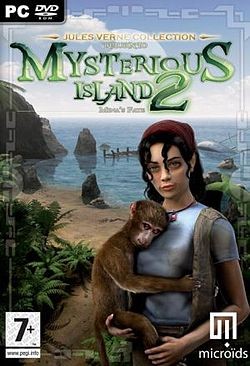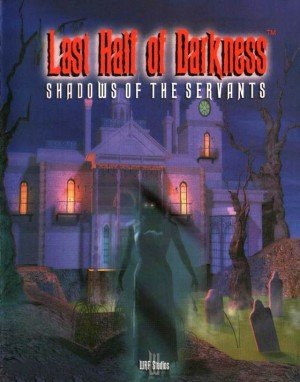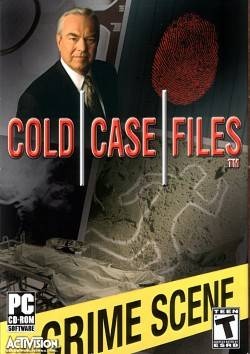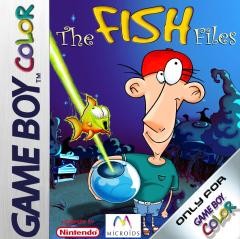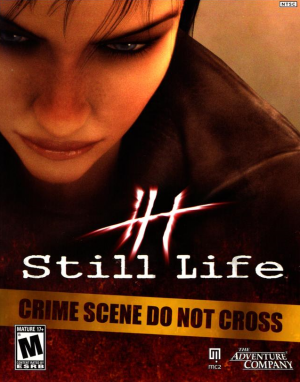Review for Return to Mysterious Island 2: Mina’s Fate

Kheops Studio’s Return to Mysterious Island came as something of a revelation in 2004. Flying well under the radar prior to release, the game looked to be much the same as countless others we’d already seen so many times before. Return to Familiar Island seemed more like it, and not just because it was set in the tropical locale first made famous by author Jules Verne. But anyone considering it nothing more than a “Myst clone with a health bar” was left eating their words – and a whole bunch of other self-prepared delectables – as the creative little adventure combined engaging real-world survivalist challenges with a clever use of inventory to make for one of the more delightful genre surprises in recent memory.
Now a half-decade later, the French studio is… uhh… returning to the… umm… mysterious island in Return to Mysterious Island 2: Mina’s Fate. Little did we realize that the young protagonist’s so-called “rescue” at the end of the first game would land her right back where she started, and more than a little worse for wear. But what of the game itself? Is it able to MacGyverishly build on the strengths of its predecessor, or is a sequel going back to the source once too often? The answer is a bit of both, as the second game shows flashes of the same charm while managing to introduce a welcome new feature, yet strays a little too far from the simple appeal of the original with an increasingly bizarre storyline that detracts from the overall experience.
The game’s primary addition is on display as soon as the action touches off. Or “splashes down”, to be more accurate, as a crash landing leaves players frantically seeking escape from a submerged helicopter while an unconscious Mina is helplessly oblivious of her impending doom. The playable character, you see, is Jep, the cute little monkey that Mina befriended in the first game. You won’t spend the whole game playing a simian, as you’ll control Mina alone on occasion, and the two pals together the rest of the time, but the inclusion of Jep as a second playable character does add some strategic twists and even an important narrative slant that gets RTMI2 off to a very promising start.
As you’d expect of a monkey, Jep is small, agile, has keen animal instincts, and is the only one that can communicate with the island’s other primates. His size is relevant, as only he can climb trees and fit into small spaces, and his nose alerts him to the presence of particularly important details. A small icon appears to indicate that a useful or dangerous object is nearby, coming into focus as you narrow in on its location. It’s an interesting concept, though it’s largely underused and only sporadically implemented, as most items don’t generate this sensory alert, and those that do can plainly be seen anyway. Still, it’s a nice touch to help create the illusion of playing a non-human character.
The ability to communicate with other monkeys is another such an attempt, though if my experience is any indication, Jep doesn’t understand his fellow creatures much better than I do. The animals’ basic emotions are indicated textually, such as “angry”, “saddened”, or “concerned”, and a reputation gauge appears onscreen to establish their current attitude towards you. To interact with each, a selection of pre-determined icons is available, allowing you to try such things as pacifying, grooming (yum, love those ticks!), offering gifts or even bullying them. However, there’s really no consistent way to predict the reaction, making the process seem like guesswork more than deductive reasoning.
There are limitations to being a monkey as well, most notably the inability to combine objects. As fans of the original game will remember, inventory connections were an essential part of the island experience, as Kheops introduced a unique interface that highlighted formulas for partially-completed combinations. This feature returns in RTMI2, but only when playing as Mina. This isn’t a significant hindrance, as the two protagonists (inexplicably) share all inventory anyway, but it does seem that complex experimentation is less emphasized this time around, often limited to the many optional tasks available to you. You can still bake cakes, paint cliffside murals with homemade paints, and go fishing for dinner with a makeshift rod, but you can skip these actions entirely if you so desire. I commend the developers for including non-essential activities, though having said that, I often found the side quests far more interesting than the required ones.
Survival is still the first order of business, of course, especially since Mina is wounded to start. As with the last game, an energy bar indicates each character’s health status, and you’ll need to scavenge for items so you can feed and sometimes nurse them back to full strength. It’s at these times where the game really shines. So many adventure game obstacles seem like blatantly contrived puzzles, and having players face real dilemmas with (more or less) real-world solutions is a welcome change. Stitching up Mina’s cut is guaranteed to be one of the more memorable inventory puzzle solutions ever, and chasing off a prowling jaguar is always satisfying. Even a little TLC goes a long way, as a hug between Mina and Jep is good for them and can’t help but warm even a jaded player’s heart a bit.
Along the way, you’ll need to successfully overcome a variety of minigames as well. These aren’t typically “win or lose” activities, but “keep trying until you get it right” types. You’ll need a quick hand to snag scurrying ants, a steady aim to fire a blowgun, and a proper sense of timing to navigate a series of tree jumps, to name just a few. You’ll also get to help Mina make some pottery, though even those who are all thumbs can’t fail at that. You’ll need more than thumbs to play a simple ocarina, however, if you plan to use tune-matching music to calm any savage beasts (there are other ways). None of the minigames are very difficult, requiring just a touch of patience more than anything else, but an “easy” option appears after a few failed attempts if you do have trouble. Regrettably, most of these activities aren’t overly engaging, either, and some are clearly better and more organic than others – slapping a rogue monkey’s thieving hands from your multi-tabbed inventory stops being fun the moment it starts – but they do add a bit of variety. No particular minigame is overused and some aren’t even required at all. There are occasions where you can “die”, but you’re instantly restored to the point before death, so it’s a very temporary setback.
Somewhere along the line, though, the focus begins to change, as if Kheops realized that a survivalist premise wouldn’t carry them through another complete game. The characters may be hungry, but will refuse to eat certain food types more than once, axes and knives won’t cut through thorny roadblocks, and Mina won’t even agree to carry Jep unless he cleans himself off each time. Such arbitrary busywork then gives way to even more abstract obstacles in the form of tile puzzles, circuit patterns, and other standalone challenges. You’ll even have to deduce a symbol code to open an underwater airlock. Who does that?! In the original game, the impulse to include these sorts of brainteasers was held off until the very end, but here it’s introduced sooner with a storyline twist that takes the game in an increasingly bizarre direction. Don’t get me wrong: while some are far too reliant on trial-and-error, the logic puzzles can be quite clever in isolation, but when conducting the latest scientific experiment, solving another mechanical breakdown, or interpreting strange runes, you can’t help but wonder when you started playing a different, far more traditional game altogether.
There is a reason for the change, of course. It isn’t just Mina and Jep at risk, it seems, as the island itself continues to be jeopardized by volcanic explosions and a mysterious green gas now threatens to envelop the local flora and fauna. Fortuitously, cryptic clues left behind by previous inhabitants tell of a hidden island base with thin ties to the Nautilus and the famous Captain Nemo that may hold the solution. So far, it all sounds rather similar to the first game, but that’s when you step into the Twilight Zone. Or at least, the next-best-Vernian thing, by means of a magical plant, a mystical force field, and an underground complex guarded by hostile monkeys, hi-tech machines, and an alien intelligence that not only links to the first RTMI, but also to Kheops’ own Voyage (or Journey to the Moon). That may sound like a colossal spoiler, but it’s little more than a plot device here to keep things moving in increasingly surreal ways. Having finished the game, I’m still not sure I understand the mind-boggling jumps the story takes, and while I appreciate the desire to interweave strands of multiple games, personally I found the sci-fi connection such an unnecessary stretch that it’s a detriment to this one.
On the other hand, the danger to the island does offer a perfect opportunity to show off the degradation visually. The lovely, if somewhat restricted, lush locations undergo an unpleasant transformation, with discoloured plants wilting, and small animals languishing, even dying. As with the first game, all this is depicted from a first-person, spin-o-rama perspective, navigated node to node by clicking directional cursors. Hardly cutting-edge stuff, but the simple style serves the game well, and the artists have done a nice job of rendering scenes both new and old, from beaches to clifftops, from subterranean caverns to the ocean floor, with stops at such locations as a windmill, a kiln, and other makeshift workshops. Ambient animations are limited, but there’s just enough cloud drift or lapping water to register activity, along with a few indigenous creatures, like a stranded giant sea turtle and coiled snakes ready to strike. Like its predecessor, RTMI2 has no lengthy video cinematics, relying instead on comic-like panels (now fully coloured) to convey important story points. I’d still have preferred a meaty opening cutscene and a rewarding finale to really punctuate the experience, but this is certainly an acceptable alternative.
What the game does show is… Mina! All but invisible as the sole playable protagonist last time, here she’s much more noticeable whenever you control Jep. But only to a point. Sadly, when playing as both characters together, you never see the other (except in an onscreen icon showing which character you currently control), and when playing only one, the second character will stay where you left them rather than follow you around. This forces you to backtrack to their position to rejoin them later, or you can access a quick-travel shortcut from the menu. Their few interactions when together are certainly worth exploring, so it’s a shame that corners were cut in this area, as I often forgot the other was with me (or wasn’t with me) for long stretches, rather negating the benefit of a dual-character adventure. Strangely, one of the few repeated character animations shows Jep “giving” items to others. This would be admirable, if not for the fact that his hand is always empty. I can willingly suspend disbelief of a monkey carrying literally dozens of items, from 21-foot wooden poles to lit fires to raw fish, but it’s probably best not to dispel the illusion so brazenly.
On the audio front, the game is also fairly sparse. Its light instrumental music is pleasant but plays only occasionally, while ambient sounds are quite suitable for the tropical setting. You wouldn’t expect a lot of voice acting from a game on a deserted island, and indeed there isn’t much, but what we do get is rock solid. Mina’s voice actress reprises her role from the first game, and while Jep is limited to a bunch of simian sounds, he’s remarkably endearing. If I had to be stuck on an island, I’d want Jep with me. Which is good, because as the story progresses, his welfare becomes inextricably linked to both your progress and your decisions, so your attitude towards him is an integral motivating factor. I’d go so far as to say that several scenes late in the game are downright poignant.
You should reach that point somewhere in the area of 10-15 hours into the game. Most games don’t require a range quite that broad, but so much of RTMI2’s gameplay comes in the form of optional activities that can significantly alter your play time. Other than, you know… for fun, there doesn’t seem to be much payoff for pursuing the extra tasks beyond a point system that rewards ambitious solutions. Even that is somewhat downplayed, however, by the fact that your score is accessible only through the inventory, and it’s never clear what actions will yield how many points, or what the maximum total is to compare your progress. There are ways to lose points as well, such as accessing the help system with the minigames, proving once again that there’s no such thing as a free lunch.
While monitoring your score, you’ll see the rest of what the interface has to offer, which should be instantly familiar to any Kheops fan. There’s a distinct inventory-combination section, a “transit” area for new item acquisitions (which continues to be more trouble than it’s worth), player character icons that can be interacted with directly, and menu options to read dialogue transcripts and documents and check your current goals. The latter proves something of a disappointment, mainly listing very general headings that add little insight to the actual tasks before you.
At the end of the day, Return to Mysterious Island 2 falls a little short of the expectations created by its acclaimed predecessor. For the most part, however, that’s not because of anything the sequel does wrong so much as certain aspects that simply weren’t handled as well as they might. When the game maintains its focus on adventurer-in-real-world scenarios, combined with a lightly touching relationship between the two protagonists, it’s a charming, often engaging experience that’s capably supported by its modest but pleasing presentation. A few too many minigames and contrived obstacles, along with a storyline that falls rather absurdly into science fiction trappings, contribute to an uneven experience overall, though there’s nothing here to discourage players completely. And for fans of the original, its budget price makes it well worth picking up. So go ahead: it’s good practice for the resourceful collecting you could and should be doing soon in your attempt to determine Mina’s Fate.
Note: The version reviewed did not contain the iPhone integration featured in later releases, and its functionality was not factored into the assessment.
WHERE CAN I DOWNLOAD Return to Mysterious Island 2: Mina’s Fate
Return to Mysterious Island 2: Mina’s Fate is available at:
- GOG -90%
- HumbleBundle
- Amazon


